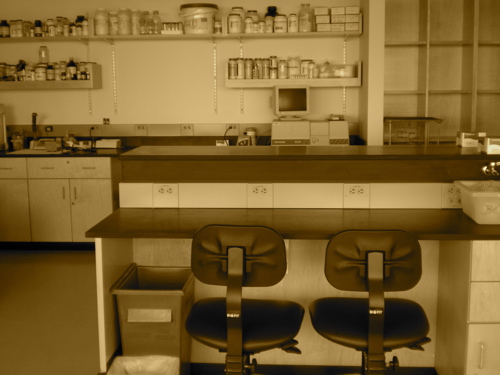20.109(S10):Aptamer binding assay (Day7)
From Course Wiki
Revision as of 20:54, 6 January 2010 by AgiStachowiak (Talk)
Contents
Introduction
Probably discuss the mechanism for the Soret shift and absorbance shifts here. However, might come earlier, especially if we do a practice binding assay, which may be prudent.
Protocols
Part 1: Purify and quantify RNA
Repeat the Day 4 protocol, parts 1 through 3. That is, purify the RNA on a column, quantify the RNA, and dilute it to 8 nmol/μL in the selection buffer. Finally, denature it at 70 °C and then let it cool for at least 10 minutes.
Note that to dilute your post-column sample, you will have to make an assumption about the ratio of 6-5 to 8-12, because they do not have the same molecular weight. What do you expect to have happened on the column?
Part 2: Prepare heme
Possibly do in advance on another day?
- A 1M stock solution of heme in DMSO has been prepared for you.
- Note that such a solution is prepared by dabbing a little heme into DMSO, and then testing the concentration on a spectrophotometer. The extinction coefficient of heme at 405 nm is 180 mM-1cm-1.
- In two steps, you should dilute the solution to 6 μM. Make enough so that you have 175 µL per sample, including a heme alone sample.
- This concentration should give you a reasonable reading on the spectrophotometer during the binding assay.
Part 3: Binding assay
- For each sample in the table below, add 175 µL of heme solution to an eppendorf tube.
- Now add 175 µL of selection buffer to the first tube. To the remaining tubes, add 175 µL of the appropriate aptamer solution.
- Incubate for five minutes at room temperature.
- Meanwhile, unwrap some microcuvettes, one for each sample. Add 350 µL of selection buffer to the first cuvette.
- Blank on selection buffer alone. Then, beginning with the heme sample, read the spectrum from 350 to 425 nm. It is essential that after each reading you send that data to the attached USB key. To do this hit More on the touchscreen twice, then press Send Data. You should also note down the absorbance value at 405 nm, and observe whether the peak has shifted away from 400 to 405 nm.
